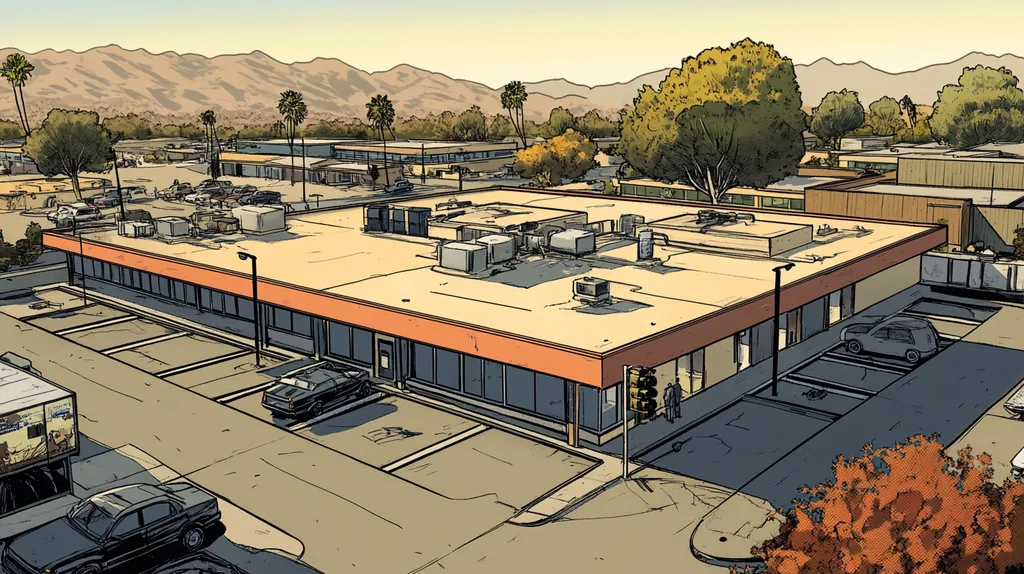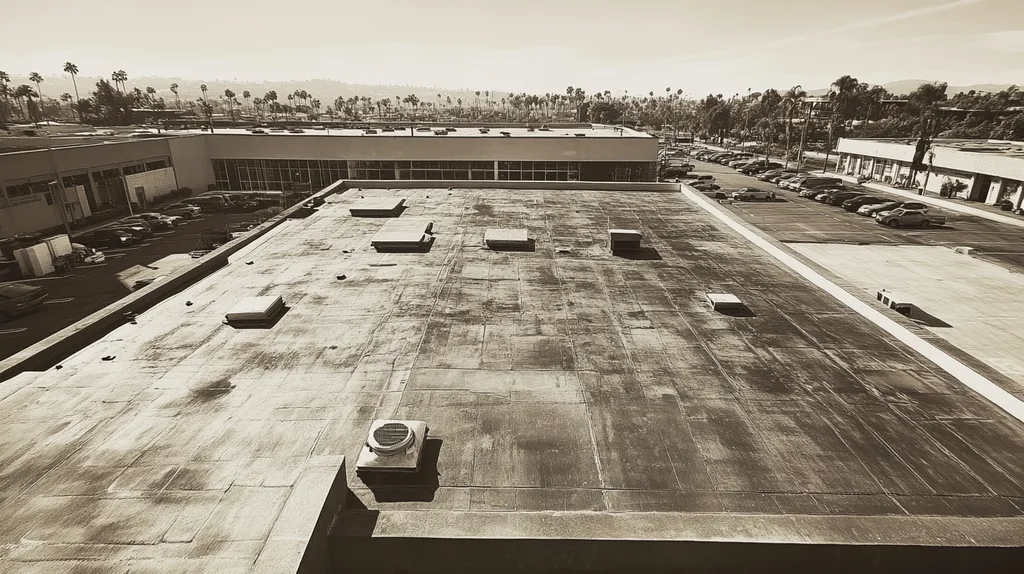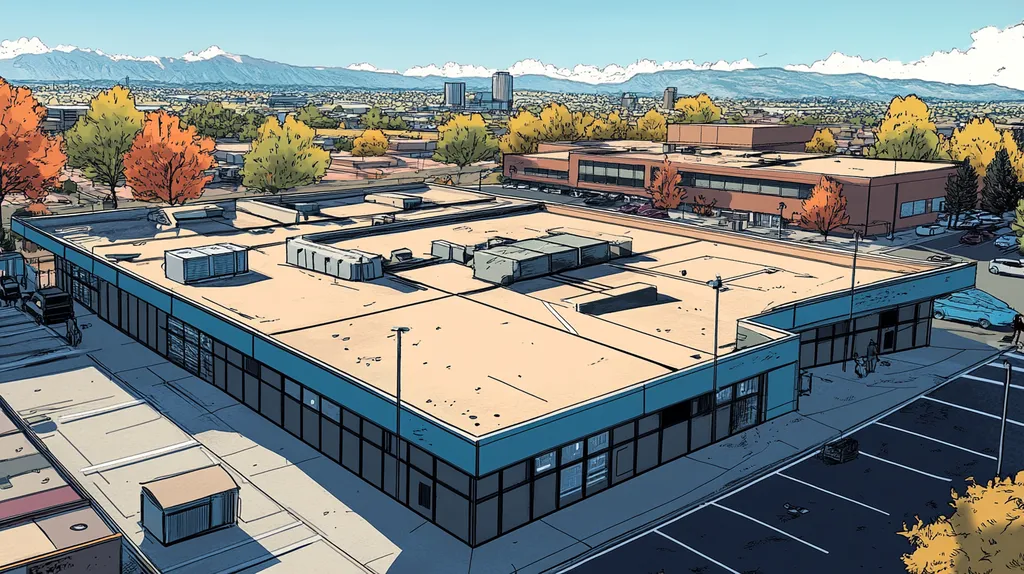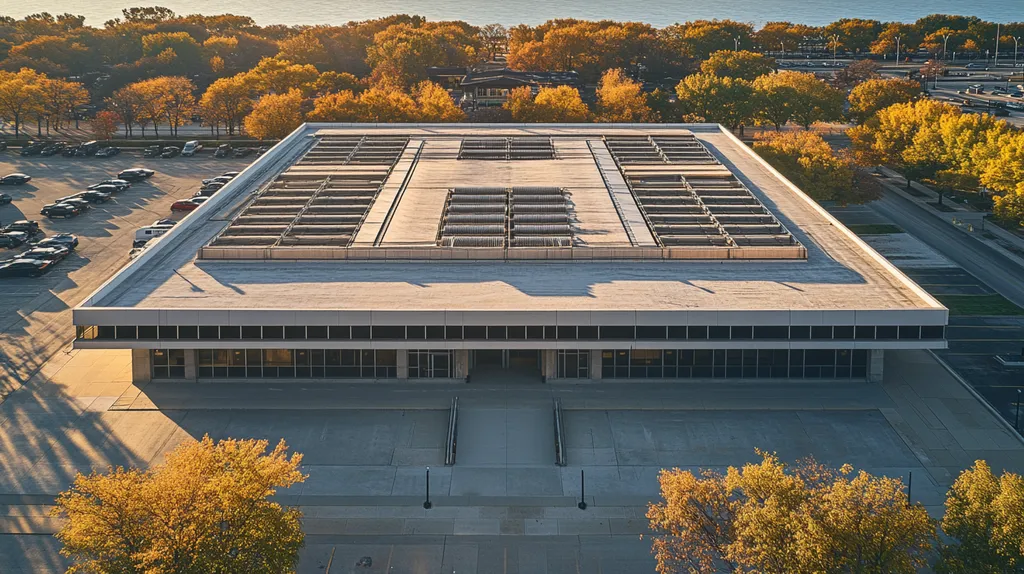In commercial roofing, gutters represent a critical yet often overlooked component that can mean the difference between a lasting roof and catastrophic failure. Industry data shows that 90% of roof damage stems from water intrusion, with faulty gutters being the primary culprit.
For facility managers, understanding gutter systems is no longer optional – it’s a necessity that directly impacts building performance, maintenance costs, and regulatory compliance.
This systematic guide examines how gutters affect everything from structural integrity to long-term operating expenses, providing actionable insights for protecting commercial properties through proper gutter management.
SECTION 1: PERFORMANCE FACTORS
Understanding the performance of commercial roofs requires a clear focus on gutters. They are essential in directing water away from the roof and the building, preventing costly damage. Neglected gutters can lead to leaks, which are responsible for 90% of commercial roof failures. This crucial insight emphasizes the need for regular gutter maintenance to ensure long-lasting roof integrity and substantial savings.
Water Flow and Drainage Efficiency
Water flow and drainage efficiency are vital for keeping commercial roofs in optimal condition. When gutters become blocked or are poorly installed, water can accumulate on the roof, leading to potential leaks and catastrophic damage.
For instance, flat roofs without proper drainage systems may face excessive pooling issues. Facilities managers must ensure gutters can effectively channel heavy rainfall, particularly in storm-prone areas.
Conducting regular inspections helps spot blockages before they escalate into significant problems. Clear gutters enable efficient water flow away from the roof and into designated drainage systems.
Key Action Items
Roof Longevity and Durability
The effectiveness of a commercial roof often depends on how well its gutters function. When water accumulates due to inefficient drainage, roofs can deteriorate rapidly, leading to significant repair costs.
Over time, accumulated moisture can seep into roofing materials, hastening degradation. High-quality gutters play a crucial role in maintaining this durability by managing water effectively.
Research has shown that properly maintained gutters can extend the lifespan of roofs by up to 20%. This can translate into substantial financial savings for properties over time.
Key Action Items
Structural Integrity Protection
Gutters are crucial in safeguarding a building’s structural integrity. Overflowing gutters can lead to erosion around the foundation, compromising the building’s stability and safety.
For example, water pooling at the base of a building may weaken foundations, resulting in costly repairs down the line. A well-designed gutter system works to redirect water away from these vulnerable areas, preserving the entire structure.
Additionally, effective gutter management reduces the risk of mold and mildew, which pose health hazards. Protecting structural integrity starts with a robust water management strategy.
Key Action Items
SECTION 2: FINANCIAL CONSIDERATIONS
When it comes to commercial roofing, gutters often don’t get the attention they deserve, but their role can have significant financial repercussions. Poorly maintained gutters can result in extensive repairs, decreased property value, and escalating operational costs. Facility managers must grasp these financial ramifications to effectively prioritize gutter systems, ensuring they’re protecting their valuable investments.
Cost of Maintenance and Repairs
Ignoring gutter upkeep can create a hefty financial burden. When gutters falter, water can accumulate on the roof or around the structure, leading to leaks and serious damage. Repairing a damaged roof can set property owners back by thousands of dollars, depending on the extent of the harm and the materials used.
Proactive gutter maintenance can prevent significant issues. Routine tasks like cleaning gutters and ensuring proper drainage can save property managers substantial sums on repairs. For instance, a building may face repair costs ranging from $1,000 to $10,000 due to water damage caused by ignored gutters.
Moreover, prolonged neglect may result in complete roof replacements, which are far more costly than regular maintenance. The initial expenses of caring for gutters are trivial compared to the potential financial strain of extensive repairs or roof replacement. Therefore, facility managers should prioritize preventive maintenance for long-term cost savings.
Key Action Items
Impact on Property Value
A properly maintained gutter system can significantly boost the property value of commercial buildings. Potential buyers often scrutinize the condition of roofs and gutters when evaluating a property. Clogged or damaged gutters can raise concerns about the property’s overall upkeep.
In fact, well-maintained roofs coupled with efficient gutter systems can lead to an increase in property value. According to a report from the National Association of Realtors, properties with adequate drainage systems may command prices that are 5% to 10% higher in the real estate market. This further underscores the importance of maintaining gutters for enhancing property value.
Conversely, neglecting gutter issues can precipitate a drop in property worth. Problems such as water leaks can give rise to mold growth, structural issues, and legal liabilities, deterring potential buyers. Recognizing this relationship is essential for facility managers as they align their maintenance strategies with robust asset management.
Key Action Items
Preventive Measures and Savings
Investing in preventive gutter maintenance can result in substantial long-term savings. Facilities that schedule regular inspections are more likely to identify issues before they necessitate costly emergency repairs. For instance, basic gutter cleaning and maintenance may cost an average of $150 to $300 annually, while a single leak repair could range from $500 to $2,000.
Utilizing a gutter monitoring system allows facility managers to receive immediate notifications about any blockages or needed repairs. This proactive strategy helps minimize unplanned expenses by facilitating timely resolution of issues. By taking preventive measures, managers can lower financial risks and avoid unpleasant surprises.
Additionally, property owners may qualify for warranties or lower insurance premiums by actively maintaining their gutter systems. Insurance companies often favor buildings with a clear maintenance history, potentially reducing risk assessments and enhancing savings.
Key Action Items
SECTION 3: COMPLIANCE REQUIREMENTS
Compliance is vital for ensuring that gutter systems function effectively and enhance overall roof performance. Facility managers must understand relevant building codes, industry standards, and inspection protocols to protect their properties. Non-compliance can lead to serious issues, including faster deterioration of roofing materials. This section highlights the essential compliance aspects related to gutters while offering practical insights for property management.
Building Codes and Regulations
Building codes set the essential standards for gutter installation and upkeep. These regulations ensure that gutters efficiently redirect water away from roofs and foundations to avoid expensive structural damage. For example, many codes require gutters to have the correct slope for optimal drainage.
Failing to comply with these codes can lead to penalties and unsafe conditions, resulting in inspector violations that necessitate costly remediation. Awareness of local codes is key to maintaining compliance and ensuring operational continuity.
In addition to protecting property, adhering to building codes enhances safety. A well-constructed gutter system can prevent flooding during intense storms, safeguarding tenants and assets alike. Facility managers should regularly consult roofing professionals to remain aware of any updates to building codes that impact their gutter systems.
Key Action Items
Industry Standards for Gutter Installation
Adhering to industry standards is essential for achieving optimal gutter performance and reliable installation practices. Organizations such as the American Society for Testing and Materials (ASTM) specify crucial guidelines that ensure gutters withstand environmental pressures.
Choosing the right materials is key; for instance, aluminum gutters are corrosion-resistant and ideal for longevity. Ignoring these standards can result in gutter failures and unpredictable water management problems.
Partnering with certified installers knowledgeable about these standards is crucial for successful gutter deployment. Proper installation enhances the gutters’ lifespan while also preserving the integrity of the entire roofing system. Facility managers should seek licensed contractors to diminish risks and guarantee performance.
Key Action Items
Inspection and Certification Processes
Regular inspections and certifications are fundamental to maintaining gutter compliance and performance. These evaluations help identify potential issues like clogs, misalignment, or deterioration before they escalate into costly repairs.
Certifications from recognized bodies indicate compliance with industry standards, instilling confidence in property managers, insurers, and financial institutions, as these may rely on compliance documentation.
Facility managers should plan for routine inspections at the beginning and end of rainy seasons, ideally every six months, especially for properties with complex drainage systems. Investing in inspections and certifications not only meets regulatory requirements but also assures that the gutter system contributes effectively to the overall roofing performance.
Key Action Items
SECTION 4: RISK MANAGEMENT
Ignoring gutter maintenance can have serious and costly implications for commercial properties. Poor drainage can lead to foundation and basement damage, foster pest infestations, and create safety hazards for employees and visitors. By recognizing these risks, facility managers can take proactive steps to enhance roof performance and protect their investments.
Foundation and Basement Damage
When gutters malfunction, water can overflow and seep towards a building’s foundation. This excess water can weaken the foundation over time, increasing the risk of structural failure. A commercial property lacking proper drainage may suffer from soil erosion, further endangering the building’s stability.
Additionally, water pooling near the foundation can infiltrate basements, causing leaks and water damage, which may lead to expensive repairs. A single incident of basement flooding can incur costs of thousands of dollars for remediation.
Moreover, inadequate gutter maintenance may elevate insurance premiums due to rising claims associated with water damage. Regular inspections and cleaning can significantly lower these risks. Effective gutter systems are essential in safeguarding the long-term viability of a commercial property.
Key Action Items
Pest Infestation and Moisture Issues
Clogged gutters create stagnant water, inviting pests such as mosquitoes, rodents, and termites. These unwanted guests can lead to health risks and harm building materials, resulting in costly extermination and repairs. For instance, termites can significantly damage a roof’s structural components if not promptly addressed.
Moreover, stagnant water in gutters can promote mold and mildew growth, degrading indoor air quality. This can adversely affect the comfort and health of occupants. Facility managers must address gutter maintenance to mitigate these issues and maintain a safe environment.
Proactive maintenance helps prevent infestations and ensures a healthy workplace. By addressing moisture issues, facility managers can protect valuable equipment and inventory, supporting seamless business operations.
Key Action Items
Safety Hazards from Neglected Gutters
Neglected gutters can present serious safety risks to employees and visitors. Overflowing gutters create slippery surfaces, increasing the chances of slip-and-fall accidents that can lead to injury claims against property owners.
Furthermore, debris buildup may cause gutters to detach or collapse, posing additional dangers. A falling gutter could injure nearby individuals and damage property. Facility managers must proactively address maintenance issues to mitigate these hazards.
Additionally, standing water can attract wildlife, which may lead to unsafe encounters for those on the property. Regular gutter inspections are essential to identify and resolve risks before they escalate into serious safety problems.
Key Action Items
SECTION 5: OPERATIONAL PROCEDURES
Managing gutter systems effectively is essential for maximizing commercial roof performance. Neglecting gutters can lead to serious consequences, such as water damage and compromised building structures. With about 25% of roof leaks originating from poorly maintained gutters, routine inspections and proactive maintenance are crucial. This section outlines operational procedures necessary for maintaining and troubleshooting gutter systems.
Routine Inspection and Cleaning
Regular inspection and cleaning of gutters are vital for preventing clogs and overflows. Facility managers should schedule these inspections at least twice a year, ideally in spring and fall. During inspections, managers must check for debris buildup, signs of rust, and secure attachments to the building.
Ensuring that gutters are free of blockages allows water to flow effectively. Ignoring minor issues can lead to major water damage if left unresolved. If any structural concerns are noted, prompt restoration is essential to prevent further complications.
Utilizing effective cleaning methods is important. A combination of manual debris removal and water flushing is recommended, as this method ensures that all blockages are cleared and potential hidden problems are identified.
Key Action Items
Gutter System Installation and Replacement
When installing or replacing gutter systems, adherence to specific guidelines is essential for ensuring optimal performance. Selecting materials that withstand local environmental conditions is crucial; for instance, aluminum and stainless steel are suitable choices for their durability.
Proper slope and alignment are fundamental during installation to allow efficient drainage. A minimum pitch of 1/4 inch for every 10 feet is often advised. Misalignment can create standing water, leading to system failure over time.
Furthermore, when replacing gutters, evaluating the current system’s performance is crucial to identify any design flaws that may need addressing. Implementing advanced systems with built-in leaf guards can significantly reduce future maintenance efforts.
Key Action Items
Troubleshooting Common Gutter Problems
Identifying and resolving common gutter issues is essential for maintaining optimal roof performance. Common challenges include clogs, leaks, and sagging gutters, each necessitating specific attention and solutions. Clogs primarily result from organic debris, which can lead to overflow if not addressed promptly.
Facility managers should inspect joints and seams for leaks caused by poor seals or corrosion. Regular application of sealant can help mitigate leaks and extend the lifespan of gutter components.
Sagging gutters often indicate failing hangers or improper slope. Adjusting the supporting hangers and realigning the gutters can effectively resolve these concerns. Following seasonal changes, like winter freeze-thaw cycles, is critical for preventing further damage.
Key Action Items
SECTION 5: OPERATIONAL PROCEDURES
Effective management of gutter systems is crucial for optimizing the performance of commercial roofs. Neglecting gutters can lead to serious issues, such as water damage and compromised building structures. With approximately 25% of roof leaks arising from poorly maintained gutters, routine inspections and proactive maintenance are essential. This section outlines the operational procedures necessary for maintaining and troubleshooting gutter systems.
Routine Inspection and Cleaning
Regularly inspecting and cleaning gutters is vital for preventing clogs and overflows. Facility managers should conduct these inspections at least twice a year, preferably during spring and fall. During inspections, look for debris accumulation, signs of rust, and any detachment from the building.
Ensuring that gutters are securely attached and free of blockages allows water to flow freely. Neglecting minor issues can escalate, resulting in significant water damage. If structural concerns are identified, timely restoration is key to preventing further complications.
Effective cleaning methods are essential—using a combination of manual debris removal and water flushing is recommended. This method ensures all blockages are cleared and helps identify hidden problems.
Key Action Items
Gutter System Installation and Replacement
When installing or replacing gutter systems, strict adherence to guidelines is essential for optimal performance. Selecting materials suited for the local environment and building design is critical; aluminum and stainless steel are often preferred for their durability and corrosion resistance.
Ensuring a proper slope and alignment during installation is vital to facilitate effective drainage. A minimum pitch of 1/4 inch for every 10 feet is generally recommended to avoid standing water and system failure.
When replacing gutters, it’s essential to evaluate the performance of the current system. This assessment can reveal design flaws that may require a complete redesign. Incorporating advanced systems with built-in leaf guards can significantly reduce future maintenance efforts.
Key Action Items
Troubleshooting Common Gutter Problems
Identifying and resolving common gutter issues is essential for maintaining optimal roof performance. Common challenges include clogs, leaks, and sagging gutters, each requiring specific attention. Clogs generally arise from organic debris, which can lead to overflow and water damage if not promptly addressed.
Facility managers should inspect joints and seams for leaks, often caused by poor seals or corrosion. Applying sealant regularly can help mitigate leaks and extend the life of gutter components.
Sagging gutters often indicate failing hangers or improper slope. Adjusting the supporting hangers and realigning the gutters can effectively resolve these concerns. Seasonal changes, such as winter freeze-thaw cycles, also necessitate immediate inspections to prevent further damage.
Key Action Items
Moving Forward
With 90% of commercial roof failures stemming from water-related damage, the importance of properly functioning gutters cannot be overstated.
Industry data shows that buildings with well-maintained gutter systems can extend their roof life by up to 20 years, while neglected systems often lead to catastrophic failures within 5-7 years.
The financial implications are clear: preventive gutter maintenance costs average $2-3 per square foot annually, while water damage repairs can exceed $30 per square foot.
As extreme weather events become more frequent, facility managers must prioritize gutter system maintenance and upgrades as core components of their risk management strategy.
The evidence is conclusive: investing in proper gutter maintenance today prevents costly failures tomorrow while protecting both property value and occupant safety.
FREQUENTLY ASKED QUESTIONS
Q. How do gutters affect commercial roof performance?
A. Gutters play a key role in directing water away from roofs, preventing leaks and damage. If neglected, they can cause water to pool, leading to significant roof failures. Regular maintenance of gutters is essential to ensure optimal roof performance and longevity.
Q. What financial impact do gutters have on an industrial roof?
A. Poorly maintained gutters can lead to expensive repairs and decrease property value. Routine maintenance is relatively inexpensive compared to the high costs associated with fixing significant water damage, which can range from thousands to tens of thousands of dollars. Therefore, investing in gutter care is a sound financial decision.
Q. What compliance requirements should facility managers know about for gutters?
A. Facility managers must be aware of local building codes and industry standards for gutter installation. Non-compliance can lead to costly penalties and unsafe conditions. Regular audits and consultations with professionals can help ensure adherence to these regulations, ultimately protecting properties and investments.
Q. How can neglected gutters lead to risks for commercial properties?
A. Neglected gutters can cause foundation damage, create pest infestations, and increase safety hazards. Water overflow can erode foundations and lead to significant repair costs, while stagnant water invites pests. Regular maintenance is critical to mitigate these risks and protect the property.
Q. What are the routine procedures for maintaining an industrial roof’s gutters?
A. Routine procedures include scheduling inspections and cleanings at least twice a year. During these inspections, check for debris, rust, and secure attachments. Utilize a combination of manual cleaning and water flushing to ensure gutters are clear and functional. Promptly address any concerns to maintain efficiency.
Q. How should facility managers troubleshoot common gutter problems?
A. Facility managers should regularly inspect for clogs, leaks, and sagging. Clear debris promptly, check joints for leaks, and apply sealant as necessary. Adjust hangers for sagging gutters and ensure alignment for proper drainage. Immediate attention to these issues prevents larger problems down the road.
Q. What are the benefits of installing gutter guards?
A. Gutter guards can greatly reduce maintenance by preventing debris build-up, ensuring efficient water flow. They minimize the need for frequent cleanings and help prevent clogs, which can lead to overflow and damage. Installing gutter guards is a practical investment for long-term performance and savings on maintenance costs.











